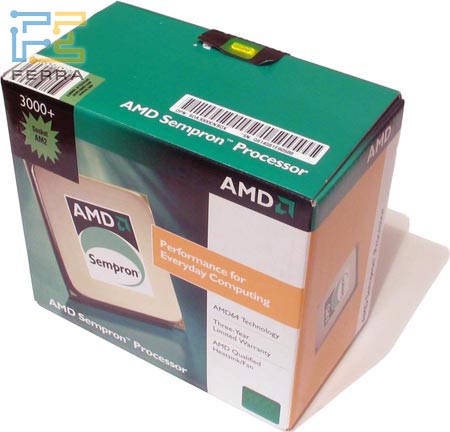In a very difficult situation in 2006, AMD announced a socket for installing an AM2 CPU. Processors for sockets 754 and 939 at that time had completely exhausted themselves and could no longer show a sufficient level of performance. As a result, it was necessary to offer something new with higher performance to provide a worthy response to the eternal competitor in the person of Intel Corporation.
How and why did this computing platform appear?
In 2006 on the market personal computers sales of a new type have started random access memory, which is called DDR2. The sockets that existed at that time for installing AMD CPUs 754 and 939 were focused on using the outdated, but most common type of RAM - DDR.
As a result, the last socket was redesigned and became known as AM2. Processors for this socket received a 30% increase in performance compared to their predecessors. The main factor that allowed such an increase in productivity was the increased throughput RAM.
Sockets up to AM2. Subsequent processor sockets
As noted earlier, the predecessors for this processor socket can be considered sockets 754 and 939. Moreover, from the point of view of organizing the functioning of RAM, it was the second of them that was closer to the hero of this review, which also had a 2-channel RAM controller. But also server socket The 940 can be considered the predecessor of the AM2. The processors in this case had an identical organization of the RAM subsystem and a similar number of contacts, which was equal to 940 pieces.

In one form or another, AM2 existed until 2009. At this time, instead of him and him updated version in the form of AM2+, a new processor socket AM3 was released, the key innovation of which was the use of a new modification of RAM - DDR3. AM2 and AM3 are physically compatible with each other. Moreover, even the AM2+ CPU can be installed in AM3. But the reverse use of the CPU is unacceptable due to the incompatibility of microprocessor RAM controllers.
Models of central processors for AM2
Socket AM2 was aimed at the following segments of the PC market:
- The Septron line of products made it possible to assemble budget system units. Such CPUs had only one computing module and a two-level cache. Technologically, these semiconductor solutions were produced at 90 nm (the CPU frequency range was limited to 1.6-2.2 GHz) and 65 nm (1.9-2.3 GHz). These chips had a very, very affordable cost and an acceptable level of performance for solving office tasks, and it is for these two reasons that they could often be found in the budget PC segment.
- The mid-segment solutions included all Athlon 64 and Athlon 64 X2 CPUs. The level of performance in this case was ensured by an increase in the size of the cache memory, higher clock frequencies, and even the presence of 2 computing modules at once (processors with the X2 prefix).
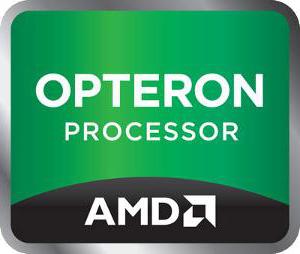
- The most productive products on this platform were the Phenom family of chips. They could include 2, 3 or even 4 computing units. Also, the cache memory size has been significantly increased.
- To create servers entry level Socket AM2 was targeted. Opteron family processors could also be installed in it. They were available in 2 modifications: with 2 computing modules (based on the Athlon 64 X2 CPU and labeled 12XX) and with 4 cores (in this case, Phenom chips acted as a prototype, and such products were already designated 135X).
Chipsets for this platform
AMD AM2 processors could be used in combination with motherboards based on the following chipsets from AMD:
- The maximum level of functionality was provided by the 790FX. It allowed you to connect 4 video cards at once in 8X mode or 2 in 16X mode.
- The niche of mid-level products was occupied by 780E, 785E and 790X/GX. They allowed you to install 2 graphics accelerator in 8X mode or 1 in 16X mode. Also, solutions based on the 790GX were equipped with a built-in Radeon 3100 video adapter.
- Even lower one step in terms of functionality were solutions based on the 785G, 785G/V and 770. They allowed the use of only 1 discrete graphics accelerator.
RAM and its controller
The AM2 socket was designed to install the newest DDR2 modules at that time. Processors, as noted earlier, received an additional 30% performance due to this important innovation. As with the 940, the RAM controller was integrated into the central processor. This engineering approach allows for increased performance with the RAM subsystem, but limits the number of types of RAM modules supported by the CPU.

The subsequent appearance of new modifications of the modules leads to the fact that the architecture of the RAM controller needs to be redesigned. It is for this reason that the intermediate solution AM2+ appeared between AM2 and AM3+. It did not have any fundamental differences from its predecessor, and the only difference was that support for DDR2-800 and DDR2-1066 RAM modules was added. In its pure form, AM2 could fully work with DDR2-400, DDR2-533 and DDR2-667. It is possible to install faster RAM modules in such a PC, but in this case their performance was automatically reduced to the DDR2-667 level, and there was no particular benefit from using faster RAM.
The current situation with this platform
Today Socket AM2 is completely obsolete. Processors and motherboards for this platform can still be found in new condition in warehouses. But it is not recommended to consider this socket as a basis even for assembling the most budget PC: the difference in price with the most affordable entry-level processor solutions of more recent sockets is insignificant, but the difference in terms of performance will be noticeable.

Therefore, such components can be used in cases where an AM2-based PC has failed and needs to be urgently restored at minimal cost.
Let's sum it up
Significant in 2006 for the world computer technology became the output connector for installing the AM2 CPU. In this case, the processors received a very significant increase in performance and made it possible to solve more complex problems. But now products based on this platform are outdated, and consider them as the basis for building a new system unit Not recommended.
At the end of spring of this year, AMD took another step towards the development of its processors, announcing new solutions that should provide support for DDR2 memory.
At the end of spring of this year, AMD took another step towards the development of its processors, announcing new solutions that should provide support for DDR2 memory. Many online and offline publications called this update to the CPU line evolutionary, not revolutionary, because no changes were made to the architecture.
A new memory controller (albeit with intentions of supporting DDR2-1066), support for virtualization technology (only for Athlon 64) and improved thermal performance of the processors themselves are not at all good reasons to declare a huge leap forward. It is very encouraging that AMD admits this without unnecessary controversy. This is confirmed at least by the fact that the rating calculation system has remained unchanged, and chips for Socket 939 and Socket AM2 are marked in this regard in the same way, that is, one rating corresponds to one frequency and one second-level cache size, and it does not matter for which socket chip.
Since the announcement of the new CPUs, many users have been wondering whether they will be able to show any significant performance increase compared to the previous generation, and whether they will be able to withstand the solutions Intel generation next. If we can partially answer the first question further, then the answer to the second will have to wait until we conduct comprehensive testing of Intel Core2Duo in our test laboratory.
Until now, most publications have tested the fastest, and, accordingly, the most expensive CPUs from AMD and Intel. In this article, on the contrary, we will try to figure out what the low-end for Socket AM2 is. Especially for this purpose, we have at our disposal the slowest of the presented chips, since they are likely to be of greatest interest to most consumers. In our opinion, there are two reasons for this: firstly, the low price, and secondly, their overclocking potential may turn out to be the best of the entire family.
Socket AM2: what's new and cheap?
Many people know that AMD has decided to replace all the processor sockets it supports, namely Socket 754 and Socket 939, with a single one – Socket AM2. There are several advantages to this. So, for example, now you don’t have to rack your brain about what to buy – a computer based on the cheaper Socket 754 or with the more expensive, productive and promising (in terms of supporting newer processors) Socket 939.
Under Socket AM2 the entire the lineup chips - from budget Sempron to very expensive Athlon 64 FX. In total, almost 30 (!) varieties of new CPUs were released. However, no more than half can be classified as budget and mainstream versions. In particular, these are all Sempron and Athlon 64 models. We will consider the youngest of them today in our article. Let's summarize their characteristics in one table:
|
CPU |
Connector |
Frequency |
Supported memory type |
L2-cache |
|
The table shows that although AMD announced that it would assign the same rating to processors with the same L2 cache size and frequency, for Sempron chips the transition to Socket AM2 still forced the company to change the rating. Thus, Sempron 2800+ and 3000+ for Socket AM2 have slightly lower performance in terms of frequency and cache size compared to their Socket 754 and Socket 939 counterparts. The difference is not significant, but it is still there and may cause some confusion in the future.
As for innovations, the main one is the new DDR2 memory controller. For all single-core AMD processors, it will be able to run at the maximum speed of DDR2-667. DDR2-800 is given to all dual-core models, because two cores require more bandwidth, and they will be able to use available channel more effective.
In addition, the heat dissipation ratings have been reduced for the new Athlon 64. If previously they were 89 W, now the TDP does not exceed 62 W. As for the so-called “energy efficient” models with a 35 W thermal package, these are more expensive versions that are not included in our review.
By the way, what’s interesting is that initially, when the Socket AM2 platform was announced, there was absolutely no mention of the Athlon 64 3000+ and Sempron 2800+. Nevertheless, such a model went on sale and also came to us for testing. We must assume that the Athlon 64 3200+ was also released. Both of the above-mentioned processors differ from the officially announced Athlon 64 3500+ only in clock frequency: the first one is 1.8 GHz, and the second one is 2.0 GHz.
It should also be added that very soon the younger models described in this article will be discontinued. This has already been officially announced. Of course, they will not disappear from sale immediately and will be available for about another year and a half. And there is no point in removing these processors right away. Due to their low cost, they should provide the most smooth transition to a new platform.
Processors
Despite the fact that the number of pins on the Socket AM2 connector corresponds to their number in Socket 940, they (the connectors) are not compatible with each other. The reason for this has also been known for a long time - the use of different memory controllers in processors.
However, apart from changing the stepping and controller, no more fundamental changes were made to the chip structure. This means that, theoretically, All K8 processor chipsets released to date are compatible with the new CPUs. Another thing is that no one will use outdated chipsets to release new motherboards.
Some changes were also made to the mount and the shape of the frame on which the cooler is attached. Now she's screwed to printed circuit board not with two bolts, as before, but with four. It is also very pleasing that all previous cooler models that had a standard mount are compatible with the new one.
Moreover, if you look at the standard box fan, it hasn't changed much either. As you can see from the picture, it can be perfectly installed on any board with a Socket 754, 939 or AM2 connector. Looking ahead, let's say that in our tests we used the Glacialtech 7300 cooler, which does not say a word about Socket AM2 support. And it seemed like nothing - the processor did not overheat and was even able to overclock.
|
|
|
Boxed version of Sempron 3000+ for Socket AM2 |
|
|
|
Boxed version of Athlon 64 3000+ for SocketAM2 |
By the way, the design of boxed versions of processors has also undergone some changes. The box is now smaller in size, although the contents remain the same: processor, user manual, case sticker and cooler.
Chipsets
We noted a little higher that, formally, any chipset can be suitable for new AMD processors. In this regard, only NVIDIA presented new versions system logic for Socket AM2. As for other manufacturers, they did not update their lines, and the companies involved in the production motherboards, announced models based on chipsets that have been available for a long time.
And NVIDIA, in fact, has made a purely cosmetic upgrade to its line of chipsets. According to the latest data, it occupies a leading position in the system logic market for AMD chips, therefore, apparently, it has become almost a matter of prestige for NVIDIA to present new line chipsets simultaneously with the release of new processors. It is worth noting that not just one of the long-released chipsets was updated, but all four discrete solutions sold under the nForce4 brand. As for integrated chipsets, NVIDIA did not touch them, and based on the GeForce 6100 and 6150 introduced last fall, new boards with support for Socket AM2 were released.
Returning to the new family of chipsets from NVIDIA, called nForce 500, a total of four modifications were released, positioned as follows:
Of all the above, we are most interested in the nForce 570 Ultra and nForce 550. Based on these chipsets, the most motherboards will be sold, since they (the chipsets) offer very good functionality at a very reasonable price. So, let's look at their characteristics:
|
Characteristic |
nForce 570 Ultra |
nForce4 Ultra |
nForce 550 |
nForce4 4x |
|
PCI Express bus |
||||
|
FirstPacket technology |
||||
|
DualNet technology |
||||
|
Number of built-in gigabit controllers |
||||
|
Maximum number of SATA devices |
||||
|
Maximum number of IDE devices |
||||
|
PCI connectors |
||||
|
Built-in sound |
What can we observe as a result? The changes affected only the functionality of the peripherals, such as built-in sound, network card and SATA and PATA controllers. nForce 550 – a kind of modernized nForce4 4x with a reduced number of IDE channels (more than two hard drives or other devices with this interface can no longer be connected), as well as with improved built-in sound, which is now HD Audio instead of AC’97.
For the nForce 570 Ultra, only the ability to install a second gigabit network card, as well as up to six SATA devices, is added. The latter allows you to create up to two RAID level 5 arrays, which for some users may be a deciding factor when choosing motherboard. As for FirstPacket technology, it is unlikely to have any serious impact on performance. For uninformed readers, let us remind you that its essence is to optimize the order of packet transmission over local network. This can be useful during online games, where the lowest possible response time (ping) is important.
As for the LinkBoost technologies (overclocking the PCI Express bus) and SLI (combining several video cards into one array), they were added to older models of nForce 500 series chipsets, which are not included in our review.
- Crazy DeepCool case - THIS is not what you expect to see
- New 18 nuclear Core i9 7980XE Extreme Edition in Regard
You can mark fragments of text that interest you,
which will be available via a unique link in the browser address bar.
From Socket AM2 to Socket AM3: compatibility illustrations
Lexagon 03/19/2007 08:32 | print version | | archive
I can’t guarantee that in other countries the problem of gradually upgrading a computer is just as acute, but in our country, buyers often think about the further possibility of upgrading the desktop system they are purchasing. AMD has long been loved for its ability to use new processors in old motherboards, but after integrating the memory controller into the processor core, ensuring such continuity has become more difficult.
The transition from Socket AM2 to Socket AM2+ was supposed to calm those AMD supporters who were afraid of the inevitable comprehensive computer upgrade. As is known, Socket AM2+ processors belonging to the K8L (K10) generation will be compatible with existing motherboards equipped with Socket AM2 connectors. You will only have to sacrifice support for the HyperTransport 3.0 bus, but continuity of platforms always requires some sacrifices, and this is not the worst of them. In addition, Socket AM2+ processors in motherboards with a Socket AM2 connector will not be able to manage their power supply as flexibly as is provided for them in “native” motherboards.
Socket AM2 processors will work in motherboards with Socket AM2+ connector, this is quite natural. Some uncertainty existed only regarding the compatibility of processors and motherboards with the Socket AM3 connector and previous platforms. Until now, it was believed that Socket AM3 processors would only be compatible with motherboards with Socket AM2+ and Socket AM3 connectors. Motherboards with a Socket AM3 socket will not be able to accept Socket AM2 and Socket AM2+ processors, since they do not support DDR-3 memory.
French colleagues from the site Hardware.fr obtained a very informative illustration at CeBIT 2007 that allows you to understand how processors and motherboards AMD three generations will get along together.

Now we can make sure that Socket AM3 processors will work in older motherboards with Socket AM2+ and even Socket AM2, since the built-in memory controller of these processors supports DDR-2. However, only Socket AM3 processors can be installed in a motherboard with a Socket AM3 socket. For ease of perception, we have made a special “compatibility matrix”:
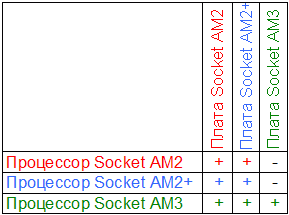
Well, fans of step-by-step upgrades can rejoice - only two of the nine combinations do not provide compatibility. For our time, a very good result.
Game in Socket
Today it is very interesting to see the intensity of passions around the upcoming platform AMD Socket AM2. On the one hand, there are no special secrets about it, because there are only a few months left before its release. Therefore, the discussion of AMD Socket AM2 is in full swing today. On the other hand, enthusiasts are eagerly awaiting the release of a new platform that could mark a major change in the PC world. Let's say exit operating system Microsoft Vista and AMD's first quad-core processor. But what the performance gain of the new platform will be, until recently remained a mystery.
It is quite interesting to see how impatiently users are waiting for the platform change, because the transition to DDR2, in itself, should not provide a large performance increase. As our tests have shown, the transition from DDR400 to DDR2-667 current versions processors does not make any noticeable differences, since the built-in memory controller suffers more from high latencies than it benefits from increasing DDR2 clock speeds. It is difficult to say whether this is due to shortcomings in the memory controller in the engineering sample of the processor. Perhaps AMD in this way protected itself from testing new processors too early.
Of course, in order for the new platform to be as attractive as possible, AMD could not rely only on low prices 1- and 2-GB DDR2 DIMMs. The platform needs high speeds memory to improve performance, and for cheap Sempron computers you can limit yourself to slow DDR2 memory. The release of the platform on June 6 seems a little late, but AMD still fits into the stated period for the second quarter, which accompanies the release of high-speed DDR2-800 memory. By the way, let's not forget that Intel plans to support DDR2-800 somewhere around the same time.
Memory is a necessary thing!
Most computers today are equipped with 512 MB or 1 GB of memory. And although a gigabyte is, in principle, enough today (see article How much memory is enough for your PC?), in the near future the optimal volume for gamers will be 2 GB. And, in principle, for work use of the computer too. And the point here is not only in the requirement of specific applications and increasing the system’s “appetite” for memory (remember the imminent release Microsoft Windows Vista), but also in changing the user behavior model. Dual core and multi-core processors provide sufficient performance for simultaneous processing of multiple tasks. They allow you to eliminate painful “brakes” when switching tasks and increase the responsiveness of the system, even if more and more services are running in the background. So why do you need to close some applications to open others? Let them all be running in the background.
You don’t have to look far for an example. Let's say that now I have a dozen applications running on my PC: Word, Excel, Photoshop, Mozilla (mail + several windows), "Kaspersky Anti-Virus", three Far windows, ABBYY Lingvo, image viewer, music player, Outlook scheduler, ICQ, Skype, etc. Just a couple of years ago it was difficult to dream about this, since the responsiveness of the system under such a load deteriorated. But thanks to dual-core processors, the system now has sufficient performance, and 2 GB of data allows you not to think about the paging file from the hard drive.
But what does the AMD platform have to do with it?
AMD made a good choice with the release new Socket AM2
There is little doubt in AMD's claim that the transition from DDR to DDR2 was technically possible back in 2005. But what was the point of this if DDR2 memory was more expensive than DDR, and performance at low speeds of DDR2 did not significantly increase? As a matter of principle, we will not discuss whether this version of the processor contains a memory error, since the crystal is still very far from the final sample for mass production.
By the way, the spread of DDR2 memory in Intel systems turned out to be too slow compared to the forecasts made a couple of years ago. The breakthrough happened only after the announcement of support for DDR2 memory in mobile platforms (about a year ago). And although Intel was unlikely to suffer, such a slow adoption of DDR2 allowed AMD to remain in an advantageous position throughout last year. The company cheerfully looked at Intel's efforts and hid behind the slogan “the best is the enemy of the good.” And she was, in principle, right.
Today the situation has changed. Although DDR2 memory is unlikely to provide a noticeable performance boost, DDR2 modules with capacities of 1 GB and above are gradually becoming cheaper than DDR1. Very soon, regular 1GB DDR2 modules (not for enthusiasts) will cost less than DDR400. Finally, configurations with 2 and 4 GB of memory can no longer be called unaffordable. The introduction of a new platform and the subsequent expectation of falling memory prices is very similar to the chicken and egg problem: what is the root cause? Luckily, AMD and Intel are planning to move to DDR2-800 at almost the same time, so the transition will be both quick and beneficial for everyone.
Socket AM2 in pictures
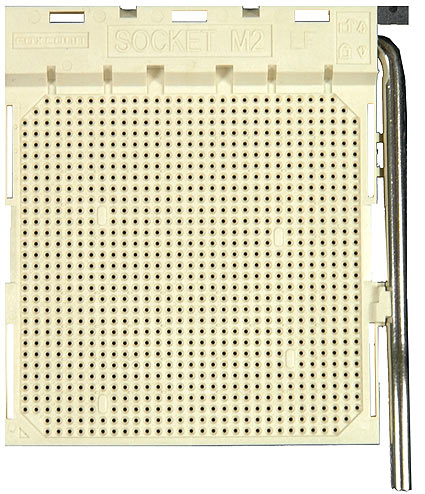
As for the number of pins, it was not at all necessary to switch to a new socket to support DDR2 memory. However, AMD nevertheless decided to make such a transition, making physical modifications: it would not be possible to install old processors in new systems (as well as vice versa), even if any adapter cards with DDR and DDR2 appeared (we remember similar solutions from Intel). So Socket AM2 (or M2, as it was called before the intellectual property issues) has 940 pins. But, despite this, it is not pin-compatible with Socket 940, familiar to us from Opteron server processors and the first FX.
Along with the release of Socket AM2 and the associated platform, AMD will present a full line of processors, consisting of six dual-core Athlon 64 X2 models, two single-core Athlon 64 and six low-cost Sempron-class processors. In addition, AMD will adequately respond to Intel's announcement regarding the transfer of all desktop processors to a 65 W thermal package. If regular Athlon 64 X2 processors have a thermal package (TDP) of 89 W, then every processor up to 4800+ will now have a “brother” with reduced heat dissipation. And all single-core processors and the dual-core 3800+ X2 will be in a thermal package of 35 W. By the way, they will continue to be produced on 200 mm substrates using the 90 nm SOI process. Although AMD is preparing to move to 65nm manufacturing with 300mm wafers, it will be several months before the company begins commercial production of processors using the new technology.
The introduction of the Socket AM2 platform will also change the specifications of coolers, and cooling system manufacturers will have to modify their existing models for Socket 754/939/940. Moreover, the change concerns not the dimensions of the mounting frame or the cooler itself, but the mounting mechanism. Of course, large assemblers will not have any problems, but overclockers and enthusiasts who bought an expensive cooler will experience certain inconveniences.
There is also positive news. We were able to install a simple cooler for Socket 939 on new system, so in some cases everything can work out. But if your cooler is directly screwed to the motherboard, then, alas, nothing will work: now four mounting holes are used, not two. Let's hope that cooling system manufacturers will release upgrade kits for expensive coolers.


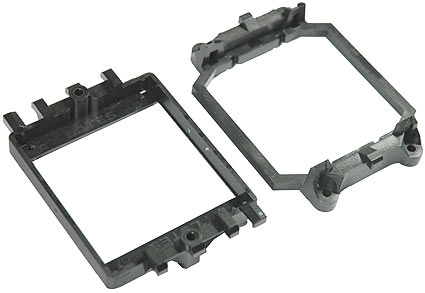
On the right is new frame cooler mounts.

Since the mounting system has changed, the new Socket AM2 platform may require a new cooler. However, some older cooler models will also work on AM2.
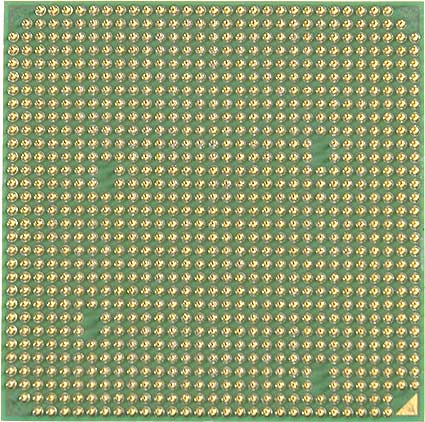
Socket AM2: no changes in chipset support
As we already mentioned during the chipset review ULi M1697, the Socket AM2 platform has no need for new chipsets, so the situation on the chipset market will remain more or less the same. In principle, any chipset that supports modern processors AMD64 line, also suitable for Socket AM2. The thing is that communication between the processor and the chipset is still carried out through the HyperTransport channel.
For some time now, the leader in the retail market for the Athlon 64 has been the nVidia nForce4 chipset. In particular, because of the excellent set of functions. ATI now offers the Radeon Xpress 200 line of chipsets, but it's still catching up to Nvidia. As for the OEM market, VIA continues to play an important role, the same can be said about ULi and SiS (although ULi is now part of nVidia).
New Athlon 64 processors
| Ruler | Model | Core | Cache | Thermal package (TDP) | Frequency |
| Athlon 64 FX | 62 | Windsor | 2x 1 MB | 125 W | 2.8 GHz |
| Athlon 64 X2 | 5000+ | Windsor | 2x 1 MB | 89 W | 2.6 GHz |
| Athlon 64 X2 | 4800+ | Windsor | 2x 1 MB | 89 W | 2.4 GHz |
| Athlon 64 X2 | 4800+ | Windsor | 2x 1 MB | 65 W | 2.4 GHz |
| Athlon 64 X2 | 4600+ | Windsor | 2x 512 kbytes | 89 W | 2.4 GHz |
| Athlon 64 X2 | 4600+ | Windsor | 2x 512 kbytes | 65 W | 2.4 GHz |
| Athlon 64 X2 | 4400+ | Windsor | 2x 1 MB | 89 W | 2.2 GHz |
| Athlon 64 X2 | 4400+ | Windsor | 2x 1 MB | 65 W | 2.2 GHz |
| Athlon 64 X2 | 4200+ | Windsor | 2x 512 kbytes | 89 W | 2.2 GHz |
| Athlon 64 X2 | 4200+ | Windsor | 2x 512 kbytes | 65 W | 2.2 GHz |
| Athlon 64 X2 | 3800+ | Windsor | 2x 512 kbytes | 65 W | 2.0 GHz |
| Athlon 64 | 3800+ | Orleans | 512 kbytes | 62 W | 2.4 GHz |
| Athlon 64 | 3800+ | Orleans | 512 kbytes | 35 W | 2.4 GHz |
| Athlon 64 | 3500+ | Orleans | 512 kbytes | 62 W | 2.2 GHz |
| Athlon 64 | 3500+ | Orleans | 512 kbytes | 35 W | 2.2 GHz |
The new processors use 90nm Windsor (two cores), Orleans (one core) and Manila (one cut-down Sempron core). All processors support 64-bit AMD64 extensions, NX Execution Bit and Cool & Quiet power saving technology. Athlon 64 processors are also equipped with AMD Pacifica hardware-accelerated virtualization technology.


CPU test processor: Athlon 64 X2 4800+ AM2
For our testing, we received an Athlon 64 X2 4800+ processor for Socket AM2, sent to motherboard manufacturing companies back in mid-December 2005. He has the same technical characteristics, the same as its Socket 939 counterpart: 2 x 1 MB L2 cache and clock frequency 2.4 GHz. However, even if it was possible to specify DDR2-800 in the BIOS of the test motherboard (also an engineering sample), the memory did not work faster than the 667 mode. As mentioned above, this could be either an error in the engineering sample or a special move by AMD to prematurely do not disclose test results. In any case, the future version of the processor (revision F) is free from this error. It's shipping to motherboard manufacturers starting this week, with single-core versions expected to ship in mid-May.
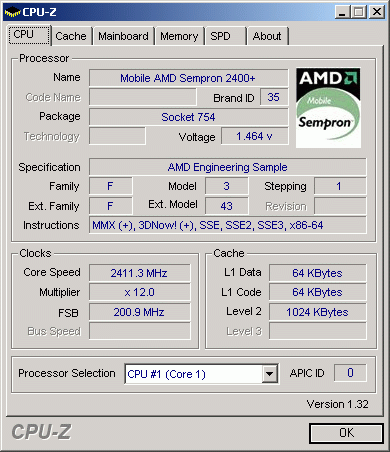
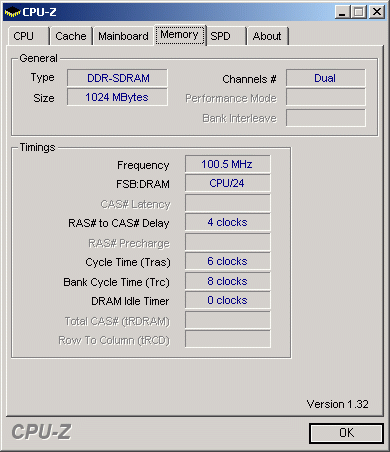
Socket AM2: impressions
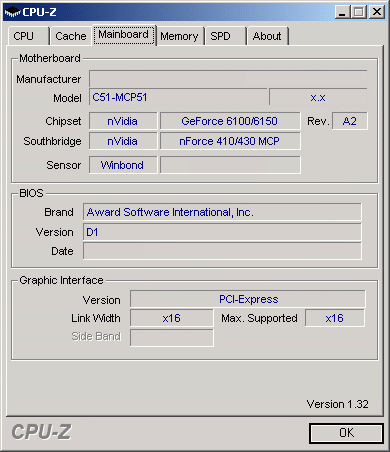
The system turned out to be surprisingly stable. Indeed, we did not encounter a single problem. But it should be recalled that Socket AM2 systems rely on existing chipsets and drivers, which can be called mature. From a platform perspective, AMD has an important advantage.
But the motherboard and BIOS are in an engineering sample state, so we couldn't change the memory latencies at all. In addition, the BIOS contains many options that it would not hurt to remove from the final version. Memory speed can be set from DDR2-400 to DDR2-667 and even DDR2-800. Additionally, 400 MHz memory speeds pair better with a 200 MHz base clock than DDR2-667 (physical 333 MHz).
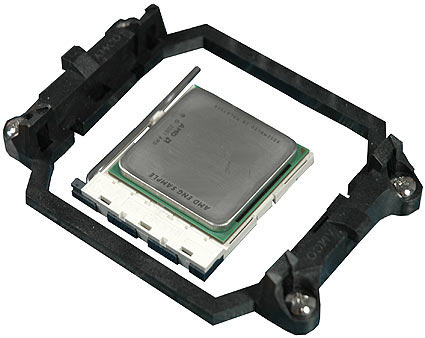
AMD Socket AM2: test configuration
| Processors | |
| Socket 939 | AMD Athlon 64 X2 4800+ Manchester (2400 MHz, 64+64/512 KB) |
| Socket AM2 | AMD Athlon 64 X2 4800+ Windsor (2400 MHz, 64+64/512 KB) Supports DDR2-667 only! The final versions of processors will also support DDR2-800. |
| motherboards | |
| Socket AM2 | MSI K8NGAM2 Rev. 1.0 Bios: 080012 Chipset: nVidia GeForce 6150 and nForce4 430 |
| Socket 939 | Asus A8N32-SLI Rev. 1.01 Bios: 1009 Chipset: nVidia nForce4 SLI X16 |
| Memory | |
| DDR2-667 | Corsair CAM2X512A-5400UL (XMS5400 V1.2) 2x 512 MB DDR2-667 (333 MHz, CL3-2-2-8, 1T) Works with latencies CL-4-4-4-12 - do not change in the BIOS of the test motherboard |
| DDR400 | Corsair CMX512-3200XLPRO 2x 512 MB DDR400 (200 MHz, CL 2.0-2-2-5 1T) |
| General hardware | |
| Graphics card (PCIe) | MSI NX7800GTX-VT2D256 GPU: nVidia GeForce 7800GTX (430 MHz) Memory: 256 MB GDDR3 (1200 MHz) |
| Hard drive I | SATA Western Digital WD740 74 GB, 8 MB cache, 7200 rpm |
| Hard drive II | SATA Western Digital WD1600 160 GB, 16 MB cache, 7200 rpm |
| DVD-ROM | Gigabyte GO-D1600C (16x) |
| Software | |
| nVidia nForce 4 SLI X16 | Forceware x16 6.85 |
| nVidia nForce 4 430/410 | Forceware 430/410 8.22 |
| Graphic arts | Detonator 81.98 |
| DirectX | Version: 9.0c (4.09.0000.0904) |
| OS | Windows XP, Build 2600 SP2 |
AMD Socket AM2: tests and settings
| Tests and settings | |
| OpenGL | |
| F.E.A.R. | Version: 1.0 Resolution: 1280x960 Computer: High Graphics Card: High Options-Performance-Test settings |
| Quake 4 | Version: 1.0.5 Beta (Dual-Core Patch) Resolution:1280x1024, High Quality Timedemo demo4.demo 1 (load textures) |
| 3DMark06 | Version 1.0 Resolution: 1024x786, 32 Bit Graphics and CPU Default Benchmark |
| Video | |
| Mainconcept MPEG Encoder | Version: 1.5.1 1.2 GB DV to MPEG II (720x576, Audio) converting |
| Pinnacle Studio 10 Plus | Version: 10.1.2.2150 from: 352x288 MPEG-2 41 MB to: 720x576 MPEG-2 95 MB Encoding and Transition Rendering to MPEG-2/DVD no Audio |
| TMPEG 3.0 Express | Version: 3.0.4.24 (no Audio) 182 MB VOB MPEG2-source (704x576) 16:9 |
| DivX 6.11 | Version: 6.1 (2 Logical CPUs) Cerfinition Profile: High Definition Profile Multipass, 3000 kbit/s Encoding mode: Insane Quality |
| XviD 1.1.0 | Version: 1.1.0 Beta 2 Encoding type: Twopass - Single pass Profile @ Level: DXN HT PAL Target size (kbytes): 570000 |
| Audio | |
| Lame MP3 | Version 3.97 Beta 2 (11-29-2005) wave to mp3 160 kbps |
| OGG | Version 1.1.2 (Intel P4 MOD) Version 1.1.2 ( Intel AMD MOD) Audio CD "Terminator II SE", 74 min wave to ogg Quality: 5 |
| Applications | |
| Winrar | Version 3.51 (303 MB, 47 Files, 2 Folders) Compression = Best Dictionary = 4096 kB |
| Autodesk 3D Studio Max | Version: 8.0 Characters "Dragon_Charater_rig" HTDV 1920 x 1080 |
| Synthetic tests | |
| PCMark05 Pro | Version: 1.1 CPU and Memory Tests |
| SiSoftware Sandra 2005 | Version 2005.7.10.60 SR3 CPU Test = MultiMedia / CPU Arithmetic Memory Test = Bandwidth Benchmark |
| Other | |
| Windows Media Player 10 | Version: 10.00.00.36.46 |
AMD Socket AM2: test results
Please note that all of our test results were obtained on pre-production processors that do not yet support DDR2-800 memory. Therefore, the results of our testing can only be used for an approximate performance analysis between the Socket 939 platform with DDR400 memory and ideal latencies CL2.0-2-2-5 1T and the Socket AM2 platform with DDR2-667 memory and average latencies CL4-4-4-12 .
Based on our testing, we should not draw too many conclusions regarding performance comparisons between the Socket 939 and Socket AM2 platforms, as the speed of the final versions may change. At the same time, the results help to understand why DDR2-800 is required for an acceptable performance increase compared to the Athlon 64 architecture and DDR400 memory.
AMD Socket AM2: OpenGL tests
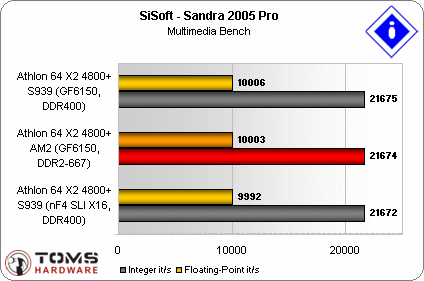
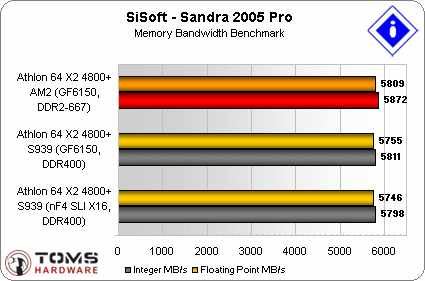
AMD Socket AM2: analysis of test results
Several facts that follow from testing should immediately be emphasized.
- The Socket AM2 generation definitely cannot be considered a fundamental step forward in performance compared to the Socket 939 (DDR400) platform, given the use of DDR2-667 memory (see test results). That is why AMD decided to wait for DDR2-800 memory and postpone the launch of the platform to June.
- Since the technical process will not change, power consumption and heat dissipation will remain at the same level as today. Of course, we did some power consumption tests, but as expected, we didn't find anything particularly significant.
- AMD plans to release processors with lower power consumption for systems sensitive to noise and power consumption. Single-core processors will operate within a thermal package of 35 W, and dual-core models will not exceed 65 W. By the way, the latter value coincides well with the thermal package of mass processors that Intel plans to release on the Conroe core in the third quarter. But we are impressed by the fact that AMD achieved a similar thermal package on 90nm technology, while Intel had to move to 65nm.
- The Sempron and Athlon lines are moving to a single Socket AM2, and now there is no need to separate cheap and expensive platforms.
- Current line of processors and motherboards Socket boards The 754/939 Athlon 64 usually supports no more than 4 GB of memory (2 GB DDR400 modules are hard to find on the market), although it is technically possible to address larger amounts. Socket AM2 platforms will easily be able to use 2GB DDR2 DIMMs at an attractive price.
- It is unlikely that overclockers and enthusiasts will like the fact that the cooler mounting mechanism has changed. However, for the average user accustomed to boxed coolers, this is unlikely to cause any trouble.
AMD Socket AM2: Conclusion

The market situation is changing. First, the Socket AM2 platform we received was just as stable as the regular retail version. Just a couple of years ago it would have been difficult to even think about this. Secondly, AMD is already ready to launch Socket AM2 and is only waiting for the right market situation. DDR2-800 and a high density of chips on DIMMs are a very favorable situation for the launch of a new platform in June 2006.
Just three years ago, AMD could not afford to postpone an important technology announcement simply because the right moment had not come (or, say, to wait for a sufficient number of processors to accumulate in warehouses). Today's lineup Athlon processors 64 is rated by many as a level above Intel, with the result that AMD is often seen as a technology market leader rather than a surviving competitor.
The transition to Socket AM2 is necessary from the point of view of DDR2 memory, which will become widespread in mid-2006 and in 2007. The transition will not have any noticeable impact on the balance of power in terms of performance, unless AMD decides to change the architecture. Let's say, transfer FX to a 4 MB cache. However, the current architecture will become the basis for the upcoming 65nm processors, which should appear towards the end of the year. Then passions should run high. We will see a very interesting rivalry between board games Intel processors Conroe and 65nm AMD processors Athlon 64. The battle will be no worse than the race for gigahertz in 2000.

